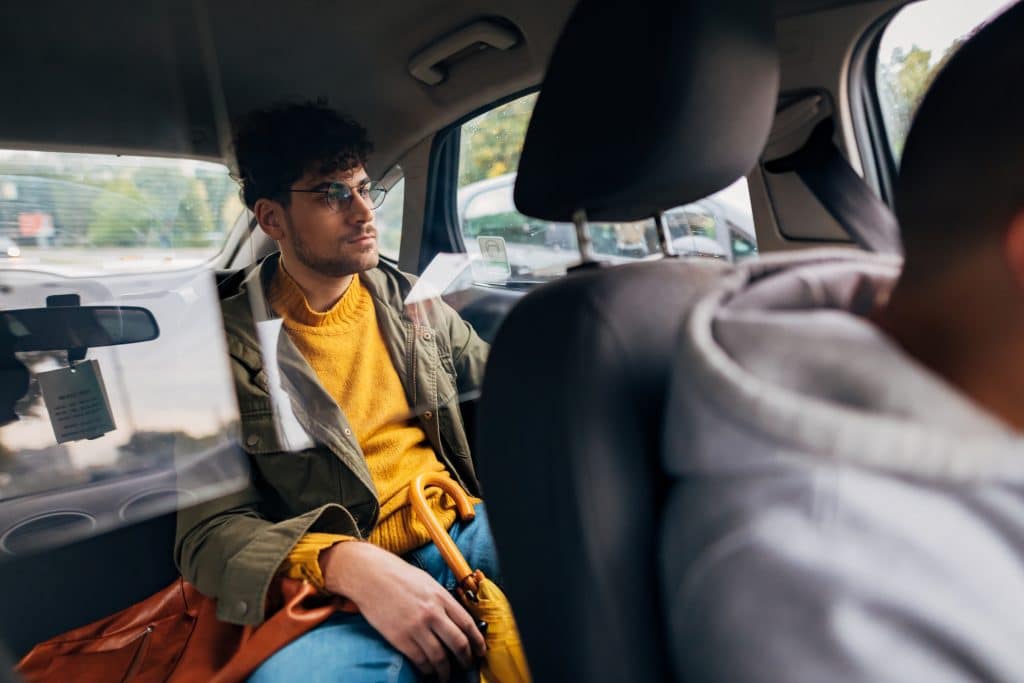You used a rideshare service for convenience and safety. After the app connected you with a driver, you settled into the back seat, trusting you would arrive at your destination without incident.
Then, another vehicle collides with your car. In the confusing moments that follow, you realize this is not a simple car accident. Multiple companies and insurance policies are involved, and none want to take responsibility for your injuries.
The reason for this confusion is clear: Rideshare insurance policies are complicated because coverage changes depending on the driver's activity at the moment of the crash.
This system creates layers of complexity that insurance companies use to their advantage. They can point fingers, delay payments, and leave you with mounting medical bills and no clear path to compensation.
Selecting the right personal injury lawyer can make a significant difference in the outcome of your case.
The Three Periods of Rideshare Insurance Coverage

The key to any rideshare accident claim is proving which period the driver was in during the collision. This determines which insurance policy—the driver’s personal auto policy or the rideshare company's commercial policy—is responsible for your damages.
- Period 1: Driver is Offline. When the driver's app is off, they are a private citizen. Their personal car insurance is the only coverage available if they cause an accident. The rideshare company has no involvement.
- Period 2: Driver is Online and Waiting for a Request. The moment a driver logs into the app and is available to accept rides, they enter Period 2. In this phase, the rideshare company’s contingent liability insurance applies if the driver causes an accident. This policy has lower limits than their full commercial policy but typically offers more coverage than state minimums.
- Period 3: Driver is En Route to a Passenger or Transporting a Passenger. This period begins when the driver accepts a ride request and ends once the passenger is dropped off. As a passenger, your accident should occur in Period 3. During this time, the rideshare company's full commercial policy is active. Major companies like Uber and Lyft typically provide at least $1 million in third-party liability coverage, as well as Uninsured/Underinsured Motorist (UM/UIM) coverage.
Who Pays for Your Injuries? Identifying the Liable Party
Because multiple insurance policies could apply, determining who pays for your medical bills, lost wages, and other damages is a major challenge. The at-fault party’s insurance company is responsible for payment.
However, establishing fault is just the first step in a rideshare accident. You must then prove which insurance policy, the driver's personal policy, the rideshare company's limited policy, or the rideshare company's full $1 million policy, is responsible for the claim.
Insurance companies will frequently dispute which party is liable. The rideshare driver’s personal insurer may deny the claim if they find out the driver was working for a commercial service. The rideshare company’s insurer may argue the driver was in a different period to avoid paying from their larger policy. If another driver caused the crash, their insurance company will be the primary source of compensation.
A lawyer can cut through this confusion by sending official letters of spoliation to preserve evidence and using legal tools to identify every potential source of compensation.
When the Rideshare Driver is At Fault
If your rideshare driver caused the accident, the available insurance depends on the period. If you were a passenger in the car (Period 3), the rideshare company’s $1 million liability policy should cover your damages.
An attorney’s job is to collect evidence, such as app data and vehicle computer information, to confirm the driver was in Period 3. This evidence prevents the insurance company from wrongfully claiming the driver was in a different period to reduce their financial responsibility.
When Another Driver is At Fault
If a different driver hit the rideshare vehicle you were in, you would first file a claim against that driver’s auto insurance policy. However, many drivers in Texas carry only the minimum amount of liability insurance, which may not be enough to cover serious injuries.
The rideshare company’s uninsured/underinsured motorist (UM/UIM) coverage should apply in this situation. This coverage protects you when the at-fault driver has little or no insurance.
A lawyer can manage the claim with the at-fault driver's insurer and then open a second claim with the rideshare company's UM/UIM policy to cover the remaining damages.
When Fault is Disputed
The most difficult situations arise when fault is unclear or disputed. The rideshare driver might blame the other driver, and the other driver might blame the rideshare driver.
Both of their insurance companies will use this dispute as a reason to deny or delay payment. An attorney resolves this by conducting a thorough investigation. They gather police reports, interview witnesses, hire accident reconstruction professionals if needed, and secure any available traffic or dashcam video.
This clarifies how the accident happened and establishes legal responsibility for your injuries.
What Tactics Do Insurance Companies Use to Deny Rideshare Claims?

Insurance adjusters work for insurance companies, not for you. Their job is to protect their company's profits by minimizing the amount of money paid out for claims.
In rideshare accident cases, the complexity of the insurance rules gives them many opportunities to try to deny or reduce your claim. They know that most people are not familiar with the three periods of coverage and may not know what their rights are.
An experienced lawyer has seen these tactics before and knows how to counter them. They can protect you from making statements that could harm your case and can challenge any unfair denials or low settlement offers.
They level the playing field, showing the insurance company that you are serious about receiving full and fair compensation for all of your losses.
- Denying the Driver’s Status: A common tactic is for the rideshare insurer to claim the driver was in Period 1 or 2, not Period 3. They may argue the driver had not yet officially accepted the ride or had already ended the trip in the app, even if you were still in the vehicle.
This moves liability to a smaller insurance policy or to the driver's personal policy, which will likely deny the claim because the driver was engaged in commercial activity.
- Shifting the Blame: The adjuster may try to argue that you, the passenger, were somehow responsible for the accident. They might claim you distracted the driver or did something else to contribute to the crash.
In other cases, they will place all blame on the other driver, even when their own driver was partially at fault. This is a strategy to avoid paying anything at all.
- Offering a Quick, Low Settlement: Before you even know the full extent of your injuries, an adjuster may contact you and offer a quick cash settlement. This offer might seem tempting when medical bills are piling up.
However, these offers are almost always far less than what your case is truly worth. Once you accept a settlement, you give up your right to seek any further compensation, even if you later require surgery or long-term care.
- Requesting a Recorded Statement: An adjuster will often ask you to provide a recorded statement about the accident. They will sound friendly and say it is just a formality.
A lawyer will advise you never to give a recorded statement and will handle all communications with the insurer on your behalf.
Frequently Asked Questions About Rideshare Insurance Policies
What should I do immediately after a rideshare accident?
First, ensure your safety and call 911 to report the accident and request medical assistance. If you can, take photos and videos of the accident scene, vehicle damage, and your injuries. Get the contact and insurance information for all drivers involved.
Importantly, take a screenshot of your ride in the rideshare app to prove what insurance period you were in. Avoid making detailed statements to anyone other than the police. Finally, contact a personal injury attorney before speaking with any insurance adjusters.
Can I use my own health insurance to pay for medical bills?
Yes, and you generally should. Your health insurance can cover your initial medical treatment while the legal system determines the at-fault party. This prevents bills from going to collections.
If you receive a settlement or award, your health insurer may seek reimbursement from those funds, a process called subrogation that your attorney can manage.
What happens if the at-fault driver who hit my Uber flees the scene?
If you are the victim of a hit-and-run while in a rideshare, the Uninsured/Underinsured Motorist (UM/UIM) coverage provided by the rideshare company during Period 3 should apply.
This covers situations just like this, providing a source of compensation when the at-fault driver cannot be identified or located.
How long do I have to file a rideshare accident claim?
The deadline, known as the statute of limitations, varies by state. For personal injury claims, it is typically two to three years from the date of the accident. However, the specific circumstances of your case can affect this deadline. Consult an rideshare accident attorney as soon as possible to ensure you do not forfeit your right to compensation.
How Can a Personal Injury Lawyer Strengthen My Rideshare Accident Claim?
A personal injury lawyer does much more than just communicate with the insurance company. They become your advocate and your investigator. They build a robust, evidence-based case demonstrating the full extent of your injuries and the financial resources you will need to recover.
This detailed and methodical process is designed to prevent an insurance company from unfairly denying your claim. The lawyer and their team get to work preserving evidence that can disappear quickly from the moment you hire them.
They manage all deadlines, paperwork, and negotiations, which frees you to focus on your medical treatment and personal recovery. A strong case presented by a legal professional often convinces an insurance company to offer a fair settlement without going to court.
But if they refuse, your lawyer will be prepared to file a lawsuit and fight for you at trial.
- Conduct an Immediate Investigation: The first step is to preserve all evidence. This includes sending official notices to the rideshare company and other involved parties to save electronic data from the app, GPS records, and any internal communications about the incident. It also means securing photos of the scene, vehicle damage, and your injuries.
- Establish the Driver's Status: A lawyer will use the evidence from their investigation to definitively prove the driver was in Period 3 at the time of the crash. This is the key to unlocking the rideshare company's full $1 million insurance policy, which provides the best source of compensation for your injuries.
- Calculate Your Total Damages: Your damages are more than just your current medical bills. A strong legal case includes a full accounting of all your losses.
This includes future medical advancement, physical therapy, lost wages from time off work, and loss of future earning capacity if you cannot return to your job. It also includes compensation for physical pain, emotional distress, and the loss of quality of life.
- Manage All Communications: Your lawyer becomes the sole point of contact for all insurance companies. This stops the adjusters from contacting you directly. It protects you from their tactics and ensures that all information provided to them is accurate and supports your claim.
- Negotiate from a Position of Strength: Armed with clear evidence of liability and a complete calculation of your damages, your lawyer will send a formal demand letter to the insurance company.
This letter outlines your case and demands a specific settlement amount. The strength of this demand forces the insurer to take your claim seriously and negotiate in good faith.
- Prepare for Trial: While most personal injury cases are settled out of court, your lawyer must be ready and willing to take action such as filing a lawsuit after an rideshare accident if the insurance company refuses to be fair. The willingness to take a case to a jury is often the most powerful tool for convincing an insurer to offer a reasonable settlement.

The laws governing rideshare accidents are designed to protect passengers, but insurance companies have a financial incentive to complicate the process.
A dedicated legal team on your side can protect your rights.
At Lorenz & Lorenz, PLLC, our cause is helping people who have been hurt in serious accidents. We believe that you should not have to fight powerful insurance companies on your own while you are trying to heal.
We handle the entire legal process, from investigation to settlement, so you can put your energy into your recovery. If you were injured in a rideshare accident, contact our office for a free and confidential consultation. Call us today at (512) 477-7333.